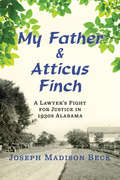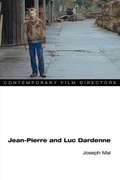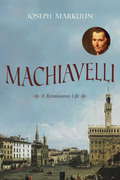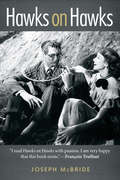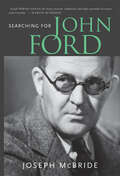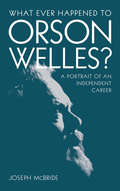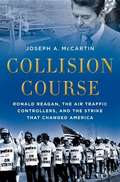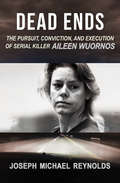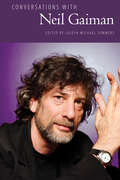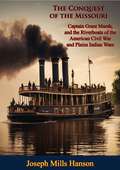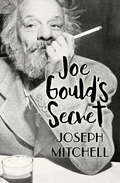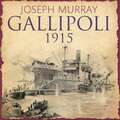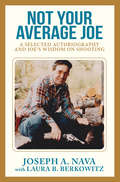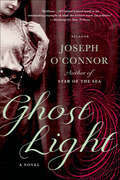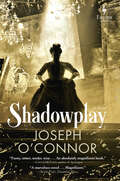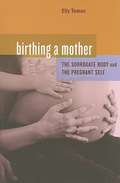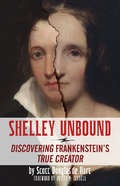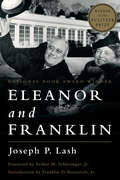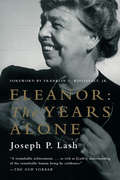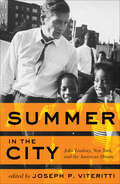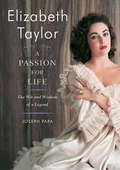- Table View
- List View
My Father and Atticus Finch: A Lawyer's Fight for Justice in 1930s Alabama
by Joseph Madison BeckThe story of Foster Beck, the author's late father, whose defense of a black man accused of rape in 1930s Alabama foreshadowed the trial at the heart of To Kill a Mockingbird. As a child, Joseph Beck heard the stories--when other lawyers came up with excuses, his father courageously defended a black man charged with raping a white woman. Now a lawyer himself, Beck reconstructs his father's role in State of Alabama vs. Charles White, Alias, a trial that was much publicized when Harper Lee was twelve years old. On the day of Foster Beck's client's arrest, the leading local newspaper reported, under a page-one headline, that "a wandering negro fortune teller giving the name Charles White" had "volunteered a detailed confession of the attack" of a local white girl. However, Foster Beck concluded that the confession was coerced. The same article claimed that "the negro accomplished his dastardly purpose," but as in To Kill a Mockingbird, there was evidence at the trial to the contrary. Throughout the proceedings, the defendant had to be escorted from the courthouse to a distant prison "for safekeeping," and the courthouse itself was surrounded by a detachment of sixteen Alabama highway patrolmen. The saga captivated the community with its dramatic testimonies and emotional outcome. It would take an immense toll on those involved, including Foster Beck, who worried that his reputation had cast a shadow over his lively, intelligent, and supportive fiancé, Bertha, who had her own social battles to fight. This riveting memoir, steeped in time and place, seeks to understand how race relations, class, and the memory of southern defeat in the Civil War produced such a haunting distortion of justice, and how it may figure into our literary imagination.
Jean-Pierre and Luc Dardenne (Contemporary Film Directors)
by Joseph MaiFor well over a decade, Jean-Pierre and Luc Dardenne have produced highly original and ethically charged films that immerse their audiences in an intense and embodied viewing experience. Their work has consistently attracted international recognition, including the rare feat of two Palmes d'Or at Cannes. In this first book-length study of the Belgian brothers, Joseph Mai delivers sophisticated close analyses of their directorial style and explores the many philosophical issues dealt with in their films (especially the ethics of Emmanuel Levinas). Mai discusses the Dardennes' varied and searching career from its inception in the late 1970s, starting with the working-class political consciousness and lost utopias of their documentary period; passing through their transition toward fictional narrative, experimental techniques, and familial themes; and finishing with a series of in-depth and philosophically informed interpretations of the brothers' more recent work. In such highly influential films such as La promesse, Rosetta, The Son, and The Child, the brothers have recast filmmaking through what Mai calls a "sensuous realism"--realism capable of touching the audience with the most compelling problems and moral dilemmas of contemporary society. This volume also features an interview in which the Dardennes discuss their approach to film production and the direction of actors.
Machiavelli
by Joseph MarkulinThis epic piece of storytelling brings the world of fifteenth-century Italy to life as it traces Machiavelli's rise from young boy to controversial political thinker. The often-vilified Renaissance politico and author of The Prince comes to life as a diabolically clever, yet mild mannered and conscientious civil servant. Author Joseph Markulin presents Machiavelli's life as a true adventure story, replete with violence, treachery, heroism, betrayal, sex, bad popes, noble outlaws, deformed kings, menacing Turks, even more menacing Lutherans, unscrupulous astrologers, untrustworthy dentists--and, of course, forbidden love. While sharing the stage with Florence's Medici family, the nefarious and perhaps incestuous Borgias, the artists Leonardo da Vinci and Michelangelo, and the doomed prophet Savonarola, Machiavelli is imprisoned, tortured, and ultimately abandoned. Nevertheless, he remains the sworn enemy of tyranny and a tireless champion of freedom and the republican form of government. Out of the cesspool that was Florentine Renaissance politics, only one name is still uttered today--that of Niccolo Machiavelli. This mesmerizing, vividly told story will show you why his fame endures.From the Trade Paperback edition.
Hawks on Hawks (Screen Classics)
by Joseph McBrideA portrait of the renowned film director based on seven years of interviews: “I am very happy that this book exists.” —François TruffautHoward Hawks is often credited as the most versatile of the great American directors, having worked with equal ease in screwball comedies, westerns, gangster movies, musicals, and adventure films. He directed an impressive number of Hollywood’s greatest stars—including Humphrey Bogart, Cary Grant, John Wayne, Lauren Bacall, Rosalind Russell, and Marilyn Monroe—and some of his most celebrated films include Scarface, Bringing Up Baby, The Big Sleep, Red River, Gentlemen Prefer Blondes, and Rio Bravo.Hawks on Hawks draws on interviews that author Joseph McBride conducted with the director over the course of seven years, giving rare insight into Hawks’s artistic philosophy, his relationships with the stars, and his position in an industry that was rapidly changing. In its new edition, this classic book is both an account of the film legend’s life and work and a guidebook on how to make movies.“There are going to be many biographies of Howard Hawks, but they will all lean heavily on this book; the pioneer so honestly reveals himself and the people with whom he worked.” —Los Angeles Times
Searching for John Ford
by Joseph McBrideJohn Ford's classic films—such as Stagecoach, The Grapes of Wrath, How Green Was My Valley, The Quiet Man, and The Searchers—have earned him worldwide admiration as America's foremost filmmaker, a director whose rich visual imagination conjures up indelible, deeply moving images of our collective past. Joseph McBride's Searching for John Ford, described as definitive by both the New York Times and the Irish Times, surpasses all other biographies of the filmmaker in its depth, originality, and insight. Encompassing and illuminating Ford's myriad complexities and contradictions, McBride traces the trajectory of Ford's life from his beginnings as “Bull” Feeney, the nearsighted, football-playing son of Irish immigrants in Portland, Maine, to his recognition, after a long, controversial, and much-honored career, as America's national mythmaker. Blending lively and penetrating analyses of Ford's films with an impeccably documented narrative of the historical and psychological contexts in which those films were created, McBride has at long last given John Ford the biography his stature demands.
What Ever Happened to Orson Welles?: A Portrait of an Independent Career
by Joseph McBrideA &“personal and passionate&” account of the Citizen Kane director&’s years as an expatriate and self-funded filmmaker (Los Angeles Times). At twenty-five, Orson Welles directed, co-wrote, and starred in Citizen Kane, widely considered the best film ever made. But Welles was such a revolutionary filmmaker that he found himself at odds with the Hollywood studio system, and his work was so far ahead of its time that he never regained the popular following he once enjoyed. Frustrated by Hollywood and falling victim to the postwar blacklist, Welles left for a long European exile. But he kept making films, functioning with the creative freedom of an independent filmmaker before that term became common and eventually preserving his independence by funding virtually all his own projects. Because he worked defiantly outside the system, Welles has often been maligned as an errant genius who squandered his early promise. Film critic Joseph McBride, who acted in Welles&’s unfinished film The Other Side of the Wind, challenges conventional wisdom about Welles&’s supposed creative decline in this first comprehensive examination of the films of Welles&’s artistically rich yet little-known later period. During the 1970s and &’80s, Welles was breaking new aesthetic ground, experimenting as adventurously as he had throughout his career. McBride&’s friendship and collaboration with Welles and his interviews with those who knew and worked with him make What Ever Happened to Orson Welles? a portrait of rare intimacy and insight. Reassessing Welles&’s final period in the context of his entire life and work, this revealing portrait of this great film artist will change the terms of how Orson Welles is regarded. &“[An] anecdote-illuminated account of Welles&’s later years.&” —The Washington Post &“Joseph McBride. . .has a clearer understanding of Welles and his films than almost anyone.&” —Martin Scorsese &“A definitive study.&” —Milwaukee Journal Sentinel
Collision Course: Ronald Reagan, the Air Traffic Controllers, and the Strike That Changed America
by Joseph MccartinIn August 1981, the Professional Air Traffic Controllers Organization (PATCO) called an illegal strike. The new president, Ronald Reagan, fired the strikers, establishing a reputation for both decisiveness and hostility to organized labor. As Joseph A. McCartin writes, the strike was the culmination of two decades of escalating conflict between controllers and the government that stemmed from the high-pressure nature of the job and the controllers' inability to negotiate with their employer over vital issues. PATCO's fall not only ushered in a long period of labor decline; it also served as a harbinger of the campaign against public sector unions that now roils American politics. Collision Course sets the strike within a vivid panorama of the rise of the world's busiest air-traffic control system. It begins with an arresting account of the 1960 midair collision over New York that cost 134 lives and exposed the weaknesses of an overburdened system. Through the stories of controllers like Mike Rock and Jack Maher, who were galvanized into action by that disaster and went on to found PATCO, it describes the efforts of those who sought to make the airways safer and fought to win a secure place in the American middle class. It climaxes with the story of Reagan and the controllers, who surprisingly endorsed the Republican on the promise that he would address their grievances. That brief, fateful alliance triggered devastating miscalculations that changed America, forging patterns that still govern the nation's labor politics. Written with an eye for detail and a grasp of the vast consequences of the PATCO conflict for both air travel and America's working class, Collision Course is a stunning achievement.
Dead Ends: The Pursuit, Conviction, and Execution of Serial Killer Aileen Wuornos
by Joseph Michael ReynoldsThe chilling true story of female serial killer Aileen Wuornos, whose violent crimes shocked the nation--and inspired the Academy Award-winning film Monster. When police in Florida's Volusia County were called to investigate the murder of Richard Mallory, whose gunshot-ridden body had been found in the woods just north of Daytona Beach in December 1989, their search led them to a string of dead ends before the trail went cold six months later. During the spring and summer of 1990, the bodies of six more middle-aged white men were discovered--all in secluded areas near their abandoned vehicles, all but one shot dead with a .22 caliber pistol--and all without any suspects, motives, or leads. The police speculated that the murders were connected, but they never anticipated what they'd soon discover: The killings were the work of a single culprit, Aileen Wuornos, one of the first women to ever fit the profile of a serial killer. With the cooperation of her former lover and accomplice, Tyria Moore, the police were able to solicit a confession from Wuornos about her months-long killing spree along Florida's interstate highways. The nation was quickly swept up in the drama of her trial and the media dubbed her the "Damsel of Death" as horrifying details of her past as a prostitute and drifter emerged. Written by the Reuters reporter who initially broke the story, Dead Ends is a thrilling firsthand account of Wuornos's capture, trial, and ultimate sentencing to death by lethal injection, that goes beyond the media frenzy to reveal the even more disturbing truth.
Conversations with Neil Gaiman (Literary Conversations Series)
by Joseph Michael SommersNeil Gaiman (b. 1960) currently reigns in the literary world as one of the most critically decorated and popular authors of the last fifty years. Perhaps best known as the writer of the Harvey, Eisner, and World Fantasy Award-winning DC/Vertigo series, The Sandman, Gaiman quickly became equally renowned in literary circles for works such as Neverwhere, Coraline, and American Gods, as well as the Newbery and Carnegie Medal-winning The Graveyard Book. For adults, for children, for the comics reader to the viewer of the BBC’s Doctor Who, Gaiman’s writing has crossed the borders of virtually all media and every language, making him a celebrity on a worldwide scale. The interviews presented here span the length of his career, beginning with his first formal interview by the BBC at the age of seven and ending with a new, unpublished interview held in 2017. They cover topics as wide and varied as a young Gaiman's thoughts on Scientology and managing anger, learning the comics trade from Alan Moore, and being on the clock virtually 24/7. What emerges is a complicated picture of a man who seems fully assembled from the start of his career, but only came to feel comfortable in his own skin and voice far later in life. The man who brought Morpheus from the folds of his imagination into the world shares his dreams and aspirations from different points in his life, including informing readers where he plans to take them next.
The Conquest of the Missouri: Captain Grant Marsh, and the Riverboats of the American Civil War and Plains Indian Wars
by Joseph Mills Hanson“A great river and those who sailed it.This well known and highly regarded classic of the opening up of the American West concentrates on the great rivers of North America and the Missouri in particular. Focus is, of course, placed to the iconic paddle-steamers, their captains and crews, that plied its waters and that have become emblematic of river navigation in 19th century America. The scope of the narrative is significant. Events are described from the mid-1850s and through the American Civil War. However, the book principally deals with the post Civil war period of westward expansion and the role of the vessels and the river itself in the wars against the plains Indians. The transportation of troops and materials played a significant part in these campaigns and this is, of course, is recounted here in some detail. Readers will learn about the exploits of boats including the 'Far West, ' 'Key West, ' Rosebud, ' 'Luella' and 'North Alabama' in this fascinating account of the American frontier afloat.”-Print ed.
Joe Gould's Secret
by Joseph MitchellIn 1942 Joseph Mitchell published "Professor Sea Gull," a profile of Joe Gould, a bohemian writer he met in Greenwich Village. Gould claimed to be at work on a vast book called The Oral History of Our Time based on conversations with the poor and downtrodden of New York City. In 1964 Mitchell published a second essay about Gould, "Joe Gould's Secret." In the second piece he describes the later years of his relationship with Gould and reveals discoveries he made about Gould before his death.
Joe Gould's Secret (Modern Library)
by Joseph MitchellThe story of a notorious New York eccentric and the journalist who chronicled his life: &“A little masterpiece of observation and storytelling&” (Ian McEwan). Joseph Mitchell was a cornerstone of the New Yorker staff for decades, but his prolific career was shattered by an extraordinary case of writer&’s block. For the final thirty-two years of his life, Mitchell published nothing. And the key to his silence may lie in his last major work: the biography of a supposed Harvard grad turned Greenwich Village tramp named Joe Gould. Gould was, in Mitchell&’s words, &“an odd and penniless and unemployable little man who came to this city in 1916 and ducked and dodged and held on as hard as he could for over thirty-five years.&” As Mitchell learns more about Gould&’s epic Oral History—a reputedly nine-million-word collection of philosophizing, wanderings, and hearsay—he eventually uncovers a secret that adds even more intrigue to the already unusual story of the local legend. Originally written as two separate pieces (&“Professor Sea Gull&” in 1942 and then &“Joe Gould&’s Secret&” twenty-two years later), this magnum opus captures Mitchell at his peak. As the reader comes to understand Gould&’s secret, Mitchell&’s words become all the more haunting. This ebook features an illustrated biography of Joseph Mitchell including rare images from the author&’s estate.
Two Ton: One Night, One Fight -Tony Galento v. Joe Louis
by Joseph MonningerBeetle-browed, nearly bald, a head that rode his collarbones like a bowling ball returning on rails, his waist size more than half his five-foot-eight height, Two Ton Tony Galento appeared nearly square, his legs two broomsticks jammed into a vertical hay bale. By all measures he stood no chance when he stepped into the ring against the Brown Bomber, Joe Louis, the finest heavyweight of his generation, in Yankee Stadium on a June night in 1939. "I'll moida da bum," Galento predicted, and though Louis was no bum, Tony, the Falstaff of boxing, lifted him from the canvas with a single left hook and entered the record books as one of the few men to put the great Louis down. A palooka, a thug, a vibrant appetite of a man, he scrapped his way out of the streets and into the brightest light in American life. For two splendid seconds he stood on the canvas at Yankee Stadium, the great Joe Louis stretched out before him, champ of the world, the toughest man alive, the mythical hero of the waterfront, of Orange, New Jersey, of an American nation little more than a year away from war. Joe Monninger's spellbinding portrait of a man, a moment, and an era reminds us that sometimes it is through effort, and not the end result, that people most enduringly define themselves.
Gallipoli 1915
by Joseph MurrayThe Gallipoli Campaign stands out as a landmark in the history of the First World War, and it was perhaps the most controversial action; it certainly ended in tragedy. Joseph Murray was among the 400,000 British and Commonwealth troops taking part, and he served as a naval rating turned soldier in Hood Battalion of the Royal Naval Division. Gallipoli 1915 is based on a diary he kept at the time and his later letters home.The Battle of Gallipoli was a war of nerves, largely played out underground in the tunnels constantly being built by either side. Joseph Murray's unflinching and compelling account gives us an insight into the daily life of a First World War soldier, as well as providing an eye-witness report of the horrors and tragedy of the conflict.
Not Your Average Joe: A Selected Autobiography And Joe's Wisdom On Shooting
by Joseph NavaBorn during the Great Depression and not expected to live at birth, Joseph A. Nava is homeless at age fifteen, loses his chance at a college football scholarship after breaking his leg, and then struggles to support his growing family. Joe finds opportunity in the challenges he faces by moving his family from Massachusetts to Alaska, with no job offer, only hope. In Alaska Joe completes his education, works at the jobs he dreamed of, and with his intense love of hunting and competitive shooting, serves not only his community but nationally on the National Rifle Association board of directors. As a wildlife biologist, hunter, executive officer of the Institute of Arctic Biology, NRA All-American shooter, licensed assistant big game guide, pilot and community volunteer, Joe shares humorous and inspiring stories. Ever the teacher, Joe provides lessons on firearms safety, hunting, competitive shooting and from his sought-after bear safety classes, how to stay safe in bear country. Through Joe's example, we learn that with hard work we can be anything we want to be.
Ghost Light: A Novel
by Joseph O'Connor1907 Edwardian Dublin, a city of whispers and rumors. At the Abbey Theatre W. B. Yeats is working with the talented John Synge, his resident playwright. It is here that Synge, the author of The Playboy of the Western World and The Tinker's Wedding, will meet an actress still in her teens named Molly Allgood. Rebellious, irreverent, beautiful, flirtatious, Molly is a girl of the inner-city tenements, dreaming of stardom in America. Witty and watchful, she has dozens of admirers, but it is the damaged older playwright who is her secret passion despite the barriers of age, class, education, and religion.Synge is a troubled, reticent genius, the son of a once prosperous landowning family, a poet of fiery language and tempestuous passions. Yet his life is hampered by conventions and by the austere and God-fearing mother with whom he lives. Scarred by a childhood of immense loneliness and severity, he has long been ill, but he loves to walk the wild places of Ireland. The affair, sternly opposed by friends and family, is turbulent, sometimes cruel, and often tender. 1950s postwar London, an old woman walks across the city in the wake of a hurricane. As she wanders past bomb sites and through the forlorn beauty of wrecked terraces and wintry parks, her mind drifts in and out of the present as she remembers her life's great love, her once dazzling career, and her travels in America. Vivid and beautifully written, Molly's swirling, fractured narrative moves from Dublin to London via New York with luminous language and raw feeling. Ghost Light is a story of great sadness and joy—a tour de force from the widely acclaimed and bestselling author of Star of the Sea.
Shadowplay: A Novel
by Joseph O'ConnorA West End theater in London is shaken up by the crimes of Jack the Ripper in this novel by the New York Times–bestselling author of The Star of the Sea.Henry Irving is Victorian London’s most celebrated actor and theater impresario. He has introduced groundbreaking ideas to the theater, bringing to the stage performances that are spectacular, shocking, and always entertaining. When Irving decides to open his own London theater with the goal of making it the greatest playhouse on earth, he hires a young Dublin clerk harboring literary ambitions by the name of Bram Stoker to manage it. As Irving’s theater grows in reputation and financial solvency, he lures to his company of mummers the century’s most beloved actress, the dazzlingly talented leading lady Ellen Terry, who nightly casts a spell not only on her audiences but also on Stoker and Irving both.Bram Stoker’s extraordinary experiences at the Lyceum Theatre, his early morning walks on the streets of a London terrorized by a serial killer, his long, tempestuous relationship with Irving, and the closeness he finds with Ellen Terry, inspire him to write Dracula, the most iconic and best-selling supernatural tale ever published.A magnificent portrait both of lamp-lit London and of lives and loves enacted on the stage, Shadowplay’s rich prose, incomparable storytelling, and vivid characters will linger in readers’ hearts and minds for many years.“A vibrantly imaginative narrative of passion, intrigue and literary ambition set in the garish heyday of a theater. . . . Artfully splicing truth with fantasy, O’Connor has a glorious time turning a ramshackle and haunted London playhouse into a primary source for Stoker’s Gothic imaginings.” —Miranda Seymour, The New York Times Book Review“A gorgeously written historical novel about Stoker’s inner life. . . . I wasn’t prepared to be awed by his prose, which is so good you can taste it. . . . O’Connor dazzles.” —Michael Dirda, The Washington Post“And Mr. O’Connor’s main characters—Stoker, Irving and the beloved actress Ellen Terry—are so forcefully brought to life that when, close to tears, you reach this drama’s final page, you will return to the beginning just to remain in their company.” —Anna Mundow, The Wall Street Journal“This novel blows the dust off its Victorian trappings and brings them to scintillating life.” —Publishers Weekly, PW Picks, Starred ReviewFINALIST 2019 COSTA BOOK OF THE YEARFINALIST 2020 DALKEY LITERARY AWARD2020 WALTER SCOTT PRIZE
19 Steps Up the Mountain
by Joseph P. BlankIt is the story of Dorothy and Bob DeBolt, who could not resist the appeal of children no one else wanted. Children of different races and nationalities, children with seemingly hopeless physical handicaps and bleak futures. It is the story of the children themselves, each learning what it meant to be loved, and what it was to overcome the most heart rending obstacles. Two parents. Nineteen children. And the single most unforgettable story that will ever leave you with mist in your eyes and joy in your heart. "A tonic for cynical and disheartened readers...This book tells clearly what it takes to be successful parents, especially when J.R.-a blind paraplegic-conquers his fear and makes it up the 19-step staircase 'mountain' alone"
Shelley Unbound: Discovering Frankenstein's True Creator
by Joseph P. Farrell Scott D. de HartFrankenstein was first released in 1818 anonymously.The credit for Mary Wollstonecraft Shelley's authorship first occurred in 1823 when a French edition was published.<P><P> A year earlier, Mary's revolutionary husband, the influential poet, dramatist, novelist, and essayist Percy Bysshe Shelley, died.The same year Frankenstein, or, The Modern Prometheus (its full title) was first published, so was another work by Mary's husband that shares use of the word Prometheus. The drama Prometheus Unbound was indeed credited to Percy Shelley.The secret admission of many experts in English literature is that Mary Wollstonecraft Shelley did not write a good portion of Frankenstein. In Shelley Unbound, Oxford scholar Scott D. de Hart examines the critical information about Percy Shelley's scientific avocations, his disputes against church and state, and his connection to the illegal and infamous anti-Catholic organization, the Illuminati.Scott D. de Hart's fascinating investigation into Frankenstein and the lives of Mary Wollstonecraft and Percy Shelley results in an inconvenient truth regarding what we have long believed to be a great early example of the feminist canon.Scott D. de Hart was born and raised in Southern California. He graduated from Oxford University with a PhD specializing in nineteenth-century English literature and legal controversies.
Eleanor and Franklin
by Joseph P. LashIn his extraordinary biography of the major political couple of the twentieth century, Joseph P. Lash reconstructs from Eleanor Roosevelt's personal papers her early life and four-decade marriage to the four-time president who brought America back from the Great Depression and helped to win World War II. The result is an intimate look at the vibrant private and public worlds of two incomparable people.<P><P> Winner of the Pulitzer Prize<P> Winner of the National Book Award
Eleanor: The Years Alone
by Joseph P. LashThe New York Times Bestseller--"Superb...Lash has reached the highest level of the biographer's art." --Wall Street Journal Joseph P. Lash, Pulitzer Prize-winning biographer and National Book Award-winning writer of Eleanor and Franklin, turns to the seventeen years Eleanor Roosevelt lived after FDR's death in 1945. Already a major figure in her own right, Roosevelt gained new stature with her work at the United Nations and her contributions to the Universal Declaration of Human Rights. She continued her activism on behalf of civil rights, as well as her humanitarian work, which led President Harry Truman to call her the First Lady of the World. Lash has created an extraordinary portrait of an extraordinary person.
Summer in the City: John Lindsay, New York, and the American Dream
by Joseph P. ViterittiThe history, policies, and legacy of John Lindsay, mayor of New York City from 1966 to 1973.Summer in the City takes a clear look at John Lindsay’s tenure as mayor of New York City during the tumultuous 1960s, when President Lyndon Johnson launched his ambitious Great Society Program. Providing an even-handed reassessment of Lindsay’s legacy and the policies of the period, the essays in this volume skillfully dissect his kaleidoscope of progressive ideas and approach to leadership—all set in a perfect storm of huge demographic changes, growing fiscal stress, and an unprecedented commitment by the federal government to attain a more equal society. Compelling archival photos and a timeline give readers a window into the mythic 1960s, a period animated by civil rights marches, demands for black power, antiwar demonstrations, and a heroic intergovernmental effort to redistribute national resources more evenly.Written by prize-winning authors and leading scholars, each chapter covers a distinct aspect of Lindsay’s mayoralty (politics, race relations, finance, public management, architecture, economic development, and the arts), while Joseph P. Viteritti’s introductory and concluding essays offer an honest and nuanced portrait of Lindsay and the prospects for shaping more balanced public priorities as New York City ushers in a new era of progressive leadership.The volume’s sharp focus on the controversies of the Mad Men era will appeal not only to older readers who witnessed its explosive events, but also to younger readers eager for a deeper understanding of the time. A progressive Republican with bold ideals and a fervent belief in the American Dream, Lindsay strove to harness the driving forces of modernization, democratization, acculturation, inclusion, growth, and social justice in ways that will inform our thinking about the future of the city.Contributors: Lizabeth Cohen, Paul Goldberger, Brian Goldstein, Geoffrey Kabaservice, Mariana Mogilevich, Charles R. Morris, David Rogers, Clarence Taylor, and Joseph P. Viteritti
Summer in the City: John Lindsay, New York, and the American Dream
by Joseph P. Viteritti“These first-rate essays provide a positive revaluation of [John Lindsay’s] mayoralty, a convincing defense of the progressive tradition he championed.” —Mike Wallace, Pulitzer Prize–winning coauthor of GothamSummer in the City takes a clear look at John Lindsay’s tenure as mayor of New York City during the tumultuous 1960s, when President Lyndon Johnson launched his ambitious Great Society Program. Providing an even-handed reassessment of Lindsay’s legacy and the policies of the period, the essays in this volume skillfully dissect his kaleidoscope of progressive ideas and approach to leadership—all set in a perfect storm of huge demographic changes, growing fiscal stress, and an unprecedented commitment by the federal government to attain a more equal society. Compelling archival photos and a timeline give readers a window into the mythic 1960s, a period animated by civil rights marches, demands for black power, antiwar demonstrations, and a heroic intergovernmental effort to redistribute national resources more evenly.Written by prize-winning authors and leading scholars, each chapter covers a distinct aspect of Lindsay’s mayoralty (politics, race relations, finance, public management, architecture, economic development, and the arts), while Joseph P. Viteritti’s introductory and concluding essays offer an honest and nuanced portrait of Lindsay and the prospects for shaping more balanced public priorities as New York City ushers in a new era of progressive leadership.“Summer in the City artfully balances the interplay of leadership, ideas about urbanism that were prevalent at the time, and deep political, intergovernmental, demographic, and economic structural forces at play in the 1960s, producing the best volume about Mayor John Lindsay ever published.” —Richard Flanagan, City University of New York
Elizabeth Taylor, A Passion for Life
by Joseph PapaFrom the time she appeared in National Velvet, the film that skyrocketed her to international fame at age twelve in 1944, until her death, Elizabeth Taylor's beauty, allure, and personal strength captivated the world. In a career that spanned more than sixty years, she brought her raw talent and magnetism to bear in now classic films such as Father of the Bride, Suddenly, Last Summer, Cat on a Hot Tin Roof, Giant, Cleopatra, and Who's Afraid of Virginia Woolf?. Off screen, she lived just as passionately. That intensity brought her enormous joy and pain-and notoriety, whether it was from her vast collections of extraordinary fine jewelry and art to her battles with addiction and ill heath, from her internationally recognized humanitarian efforts on behalf of AIDS to her scandalous love affairs and seven highly scrutinized marriages. This anthology reveals the candor and honesty with which the actress led her extraordinary life. Here are Elizabeth's first-person reflections on her childhood, career, love and marriages, motherhood, beauty, aging, extravagances, charity, and sense of self. Whether witty or poignant, these words are always demonstrative of her generous, unapologetic, and fiercely determined nature, reflecting the essence of a great star and legendary modern woman.
Elizabeth Taylor, A Passion for Life
by Joseph PapaFrom the time she appeared in National Velvet, the film that skyrocketed her to international fame at age twelve in 1944, until her death, Elizabeth Taylor's beauty, allure, and personal strength captivated the world. In a career that spanned more than sixty years, she brought her raw talent and magnetism to bear in now classic films such as Father of the Bride, Suddenly, Last Summer, Cat on a Hot Tin Roof, Giant, Cleopatra, and Who's Afraid of Virginia Woolf?. Off screen, she lived just as passionately. That intensity brought her enormous joy and pain--and notoriety, whether it was from her vast collections of extraordinary fine jewelry and art to her battles with addiction and ill heath, from her internationally recognized humanitarian efforts on behalf of AIDS to her scandalous love affairs and seven highly scrutinized marriages.This anthology reveals the candor and honesty with which the actress led her extraordinary life. Here are Elizabeth's first-person reflections on her childhood, career, love and marriages, motherhood, beauty, aging, extravagances, charity, and sense of self. Whether witty or poignant, these words are always demonstrative of her generous, unapologetic, and fiercely determined nature, reflecting the essence of a great star and legendary modern woman.
